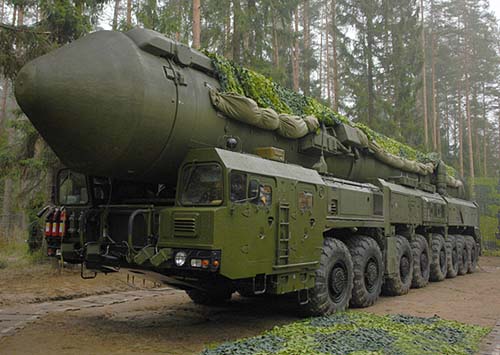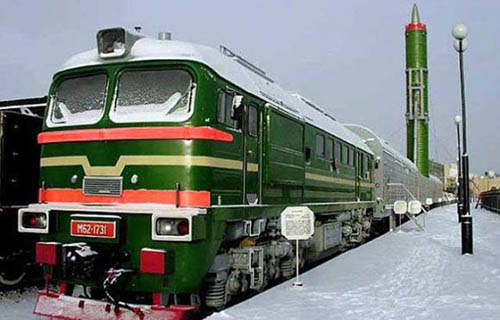Successfully launched an intercontinental ballistic missile from the Plesetsk cosmodrome, northwest of Russia. This is what is read in a note from the Russian Ministry of Defense.
The test was carried out to verify the technical and stability characteristics of the system Topol-M (SS- 27 Sickle-B). The autonomous inertial-type guided missile with Glonass interface continues to demonstrate high precision and, overall, good performance, hitting the designated target on the firing range in the Kamchatka Peninsula, Russia.
The three-stage missile Topol in usual propellant, redesigned in the years' 90, it is considered immune to American anti-missile shield (ABM), thanks to its ability to make sharp turns, release false targets and complete shielding against any type of Emp or laser attack. The only possibility to bring it down would be in the boost phase (Boost Phase): a task that would be up to the interceptors based in Poland. With its eleven thousand km range, the Topol could hit any part of the United States with impunity. Its probability of circular error is estimated in 350 meters: it carries a single warhead with a maximum yield of 550 kilotons.
Il Topol, made mostly of carbon fiber, was designed by the Moscow Institute of Thermal Technology, to be easily converted for the maximum transport of six warheads MIRV. Unlike its US counterpart, the Topol it can be launched either from mobile ramps or from silos.

Russia currently has 326 intercontinental ballistic missiles with about 1.050 warheads ready to launch (Mirv-Marv). The Ministry of Defense has already announced the withdrawal of almost all the now obsolete Icbm like the SS-18 Satan, SS-19 Stiletto and SS-25 Sickle (Topol) to replace them with SS-27 Sickle-B (Topol-M) and RS-24 yars by 2021.
Unlike the triad American nuclear, Russia provides a fourth option, defined as the Land SSBN. Part of the mobile nuclear arsenal is scattered throughout the vast Russian territory. This approach makes it impossible to determine exactly the position of the mobile launchers. There Land SSBN it was designed to guarantee mutual destruction.
The RS-24 yars (codename Nato SS-29) is a fifth generation intercontinental ballistic missile. It is an updated version of the ballistic missile Topol-M and was tested and officially presented in the 2007, in response to the installation of NATO's missile shield in Poland. The RS-24 is able to hit targets at a maximum distance of twelve thousand kilometers with an error of 50 meters. It is one of the fastest ICBMs in the world, with a final acceleration to over 20 mach. The RS-24 yars also equips Russian nuclear trains. Flight tests should start by March. The tests must validate the design solutions adopted and the impact of the missiles on the starting platforms.
 In the 1969 the Soviet Union, in response to the nuclear power of US submarines, deployed perfectly disguised atomic trains throughout the country and, in fact, canceled the American military satellite survey. The RT-23 Molodets called Combat Railway Missile Complex they were equipped with three RS-22 ballistic missile launchers. THE Molodets have been removed from the service in the 1993. Of the 12 missile trains of the Soviet era, 10 were destroyed and two were handed over to a museum.
In the 1969 the Soviet Union, in response to the nuclear power of US submarines, deployed perfectly disguised atomic trains throughout the country and, in fact, canceled the American military satellite survey. The RT-23 Molodets called Combat Railway Missile Complex they were equipped with three RS-22 ballistic missile launchers. THE Molodets have been removed from the service in the 1993. Of the 12 missile trains of the Soviet era, 10 were destroyed and two were handed over to a museum.
The Kremlin, last September, started the production of the new death trains. Unlike the previous ones, the new ones Barguzin At the Institute of Thermal Technology in Moscow, they will be able to launch from anywhere in the vast Russian railway. It should be noted that the same institute has designed all the strategic solid fuel missiles of the country, such as the Topol-M, Bulava e yars. Each train, clearly lighter than the Molodets, should carry six RS-24 missiles, each capable of carrying four Mirv-Marv warheads (from the sixth train onwards). Only one train could launch 24 thermonuclear warheads with independent multiple re-entry. This means that only one train may be able to target 24 cities. The new trains will have to withstand the shock wave of a nuclear warhead and will be able to travel up to one thousand kilometers a day at 100 kilometers with a one-month autonomy. Five new trains are in production, while the entire logistic support has been kept operational by the Russians. All the necessary infrastructures working, including the deep tunnels where the trains cannot be detected by any form of reconnaissance or destroyed by a nuclear attack.
Each rail division will consist of five trains, each of which is considered a regiment. The initial estimate included the entry into service of the Barguzin by 2019, but has been postponed for a year. Every nuclear train should remain in service for twenty years with thirty-day patrols. The new START III treaty, signed in the 2011, does not limit rail ICBMs.
(photo: MoD Russian Federation)












